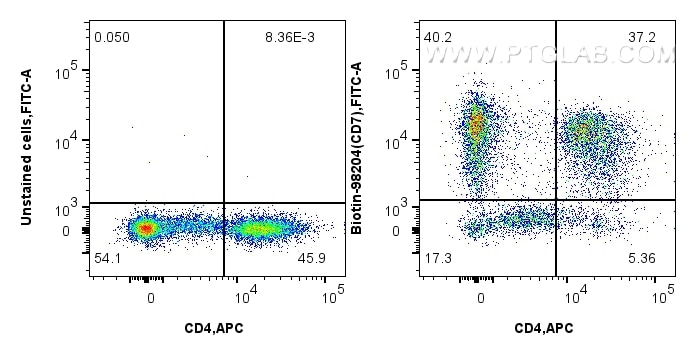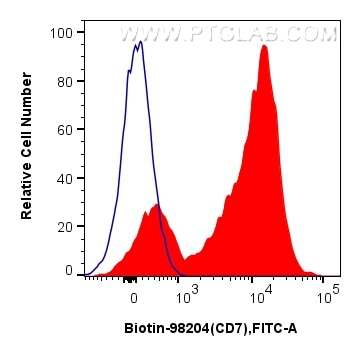Validation Data Gallery
Tested Applications
| Positive FC detected in | human PBMCs |
Recommended dilution
| Application | Dilution |
|---|---|
| This reagent has been tested for flow cytometric analysis. It is recommended that this reagent should be titrated in each testing system to obtain optimal results. | |
| Sample-dependent, Check data in validation data gallery. | |
Product Information
Biotin-98204 targets CD7 in FC applications and shows reactivity with human samples.
| Tested Reactivity | human |
| Host / Isotype | Rabbit / IgG |
| Class | Recombinant |
| Type | Antibody |
| Immunogen | Recombinant protein 相同性解析による交差性が予測される生物種 |
| Full Name | CD7 molecule |
| Calculated molecular weight | 25 kDa |
| GenBank accession number | NM_006137.7 |
| Gene Symbol | CD7 |
| Gene ID (NCBI) | 924 |
| ENSEMBL Gene ID | ENSG00000173762 |
| Conjugate | Biotin |
| Form | Liquid |
| Purification Method | Protein A purification |
| UNIPROT ID | P09564 |
| Storage Buffer | PBS with 0.09% sodium azide , pH 7.3 |
| Storage Conditions | Store at 2-8°C. Avoid exposure to light. Stable for one year after shipment. |
Background Information
CD7, or T-cell antigen 7 or GP40, is a transmembrane glycoprotein and a member of the immunoglobulin supergene family. CD7 is predominantly expressed on thymocytes and mature T cells, as well as natural killer (NK) cells, and it is one of the earliest antigens to appear on cells of the T-lymphocyte lineage. CD7 plays a significant role in T-cell and T-cell/B-cell interactions during early lymphoid development. It is involved in the regulation of cell signaling and biology, including T-cell activation, proliferation, and the expression of interleukin-2 receptor alpha (IL-2Rα). CD7 is not only a marker for T-cells but also has functional implications in immune cell interactions and adhesion. It can provide co-stimulatory signals and is associated with CD3 and CD45, participating in T-cell activation.
Protocols
| Product Specific Protocols | |
|---|---|
| FC protocol for Biotin CD7 antibody Biotin-98204 | Download protocol |
| Standard Protocols | |
|---|---|
| Click here to view our Standard Protocols |

